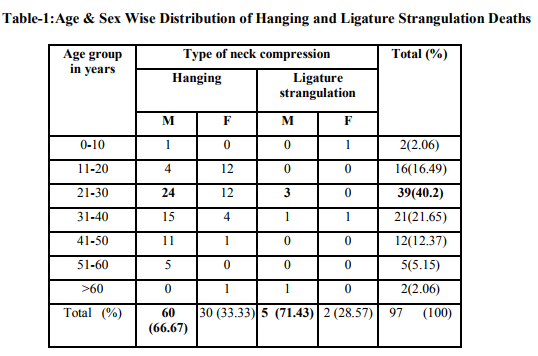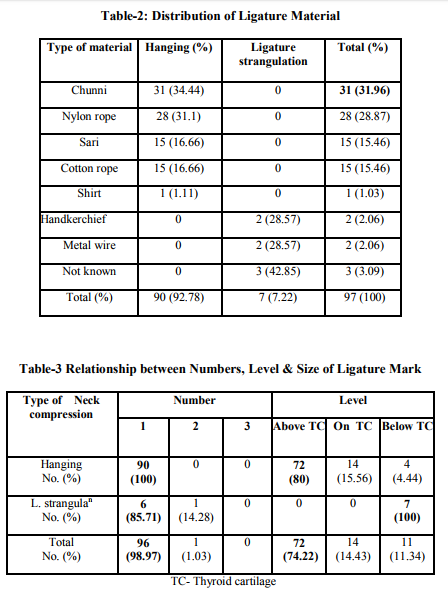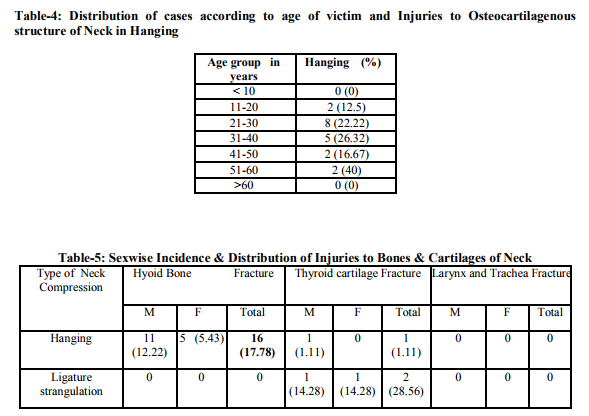IJCRR - 4(18), September, 2012
Pages: 60-65
Date of Publication: 29-Sep-2012
Print Article
Download XML Download PDF
POSTMORTEM STUDY OF FRACTURE OF NECK STRUCTURES IN HANGING AND LIGATURE STRANGULATION DEATHS
Author: Sadikhusen G. Momin, Sanjeevkumar Choudhary, Hetal C. Kyada, Dipak H. Vora
Category: Healthcare
Abstract:Background: The Hyoid bone is the most important part of internal examination at the autopsy table while performing autopsy in cases of Hanging and Ligature strangulation. Fracture of hyoid bone has been ascribed to many factors like manners of constriction, level of application of ligature material or force of constriction, long drop or short drop suspension, age and sex of victim etc. It is also very important to check whether it is ante mortem or postmortem in nature or just an artifact. Observing the importance given to hyoid bone fracture in hanging and ligature strangulation cases by many authors in past and present days, the present prospective study was performed on asphyxial deaths due to hanging and ligature strangulation. Objectives: To study the fracture of neck structures in hanging and ligature strangulation deaths. Study Design: Prospective study. Study Setting: This study was conducted at P.D.U. Medical College and Hospital, Rajkot during January 2008 to December 2008. Result: During that period out of 2159 cases, 90 cases of hanging and 7 cases of ligature strangulation were selected for the present study. Hyoid bone was fractured in 16 cases (17.78%) of hanging. In one case (1.11%) of hanging where thyroid cartilage was fractured. In two cases (28.56%) of ligature strangulation, thyroid cartilage was fractured. No fractures of the cricoid cartilage or cervical spine were demonstrated. Conclusion: Incidences and postmortem findings of fracture of neck structures in cases of hanging and ligature strangulation were almost same which was observed by the other recognized authors in the field.
Keywords: Hanging, Ligature strangulation, Fracture of Hyoid bone, Fracture of Thyroid cartilage
Full Text:
INTRODUCTION
Osteocartilagenous structures of neck like hyoid bone, thyroid cartilage, tracheal cartilages and cervical vertebrae show injury with variable incidences in cases of hanging and ligature strangulation. Hyoid bone is commonest to be injured in conventional hanging cases, whereas fracture or dislocation of cervical vertebrae may be noticed in judicial hanging where the victim jumps from a height and his fall is arrested by a sudden jerk of ligature. The fracture of hyoid bone depends on age of individual and type of compression. After the ossification of greater cornu with body after 40 years there is loss of mobility and in turn variation in incidence of fracture of hyoid bone in case of hanging has been reported by different workers i.e. 4.9% by Patel et al1 , 15.38% by Gargi et al2 , 9.4% by Momonchand et al3 and 5.1% by Sheikh et al4 . The type of hyoid bone fracture (if present) can help to decide the manner of neck compression hanging or strangulation (ligature or manual). Commonly, the lateral compression fracture is seen in strangulation and anteroposterior fracture of hyoid bone suggests hanging. However, whether the each fractured piece displaced inward or outward and opinion about type of neck compression needs careful observation and expert interpretation5 .
MATERIAL AND METHOD
This prospective study was conducted in all cases of death due to hanging and ligature strangulation for the purpose of studying the fracture of neck structures at the Department of Forensic Medicine, P.D.U. Medical College and Hospital, Rajkot from January 2008 to December 2008. During that period out of 2159 cases, 90 cases of hanging and 7 cases of ligature strangulation were selected for the present study. A detailed history from police and relatives regarding age, sex, socio economical status, marital status, habits, illness (mental / other disease / deformity), previous attempted suicides, suicide note if any etc. were taken. Detailed history from police regarding scene of crime, position of body etc. were taken. Irrespective of information collected, both external and internal post mortem findings were observed meticulously. Neck structures were inspected carefully; neck dissection was conducted for presence or absence of fractures of bony structures of neck. The tongue, larynx and trachea were removed carefully. Then the findings were confirmed by meticulous dissection to observe hemorrhage in and around the fractured area.
OBSERVATIONS
Total number of 2159 cases was brought for postmortem examination during the period from 01-01-2008 to 31-12-2008, out of which 97 cases (4.49%) of hanging and ligature strangulation were studied. Maximum 39 cases (40.2%) of hanging and ligature strangulation deaths were reported in age group of 21-30 years. Out of 36 cases, 24 (64%) male and 12 (34%) female died due to hanging while 3 case of ligature strangulation equal reported in male. Chunni was used as a ligature material in maximum 31 cases (34.44%) of hanging followed by nylon rope in 28 cases (31.1%) whereas in ligature strangulation cases, ligature material was not known in maximum number 3 cases (42.85%). As per Table-3, in all cases of hanging only one ligature mark was present. The ligature mark was situated above thyroid cartilage in 72 cases (80%) of hanging. Ligature mark was one in number in 6 cases (85.71%) of ligature strangulation, in all 7 cases (100%) it was situated below thyroid cartilage. As per Table 4, injuries to osteocartilagenous structures of neck were highest in hanging cases in age group of 31 to 40 years followed by 21 to 30 years age group. Incidence is increasing with increase in age. In 90 cases of hanging, hyoid bone was fractured in 16 cases (17.78%). Out of 16 cases, 11 cases (12.22%) were male and 5 cases (5.43%) were female. While in one case (1.11%) of hanging, thyroid cartilage was fractured and in 2 cases (28.56%) of ligature strangulation, thyroid cartilage was fractured. Hyoid bone was not fractured in any case of ligature strangulation. Larynx, trachea and cervical vertebra were not fractured in any case of hanging and ligature strangulation.
SUMMARY AND CONCLUSION
1. In the present study 4.49% cases were declared on autopsy of hanging and strangulation deaths which is similar to study of Sheikh et al4 .
2. In the present study maximum number of cases (40.2%) were reported in the age group 21-30 years, which is consistent with observations of Sheikh et al4 (42.4%) and Joshi et al7 (44.18%). 21-30 years age group involves maximum because they are more vulnerable to the fast changing social trends and cultures, as they are mentally a bit immature with little experience of life and there is great fluctuation of emotion in this age group.
3. In hanging cases 66.67% male and 33.33% female cases were observed in present study, which is consistent with observations of Sheikh et al4 and Jani et al6 . This could be due to more activeness of male in society and less carelessness in females. Males are more active in various activities and customs and hence they are vulnerable for more stress and tension.
4. Chunni as a ligature material was used in 34.44% cases of hanging in the present study. In study by Sharma B R et al8 commonest ligature material was chunni in 17 cases (30.90%). The reason for selecting chunni can be explained on the basis of easy availability in Indian house.
5. Number of ligature mark is one in all cases of hanging are similar with observation of Momonchand et al3 (96.7%). In present study six case of ligature strangulation where number of ligature mark is one while in one case, number of ligature mark is more than one. Ligature mark was situated above the level of thyroid cartilage in 72 cases (80%) of hanging which is similar with observation of Naik S K9 (82.94%). In all 7 cases (100%) of ligature strangulation, ligature mark was found below thyroid cartilage. 6. Incidence of fracture of hyoid bone in present study (17.78%) is almost similar with Simonsen10 (17.5%) and Jani et al6 (17.4%). 7. Incidence of injuries to osteocartilagenous structure of neck in hanging cases increases with increase in age. The observations of present study are consistent with the work of other workers.6,11,12 8. The percentage of hyoid bone fracture in hanging deaths vary greatly from 0% to 68% from author to author when we look into different text like Wintraub (1961) reported in 27% cases of hanging13, Betz P. and Eisenmenger W (1996) reported Throat skeleton fracture seen in 67% hanging14 , Nikolic S, Micic J, Antanasijevic T, Djokic V. and Djonic D(2003) reported Throat skeleton fracture seen in 68% hanging15 and Reddy K.S.N.(2008) seen in15-20% cases of hanging but rare below 40 years of age5 .
ACKNOWLEDGEMENT
Authors acknowledge the immense help received from the scholars whose articles are cited and included in references of this manuscript. The authors are also grateful to authors / editors / publishers of all those articles, journals and books from where the literature for this article has been reviewed and discussed.
References:
1. Patel H R and Kothari D R. A study of asphyxial deaths from 1985 to 1989 at a hospital at Ahmedabad. The special Conference Issue of Indian Academy of Forensic Medicine, Calcutta 1992; 107-114.
2. Gargi J, Gorea R K, Chanan A and Mann G. Violent asphyxial deaths- a six year study (1985-1991). The special Conference Issue of Indian Academy of Forensic Medicine, Calcutta 1992; 171-176.
3. Momonchand A, Meeradevi T. H. and Fimate L. Violent asphyxia death in Imphal. Journal of Forensic Medicine and Toxicology (1998); 15(1):60-64.
4. Sheikh M I and Agarwal S S. Medicolegal implications of hyoid bone fracture- a study paper. Journal of Indian Academy of Forensic Medicine. (2001); 23(4):61 – 63.
5. Reddy K S N. The Essential of Forensic Medicine and Toxicology, 27th edition, K. Saguna Devi. Hyderabad (2008); 313-14.
6. Jani C B and Gupta B D. An autopsy study of parameter influencing injury to osteocartilagenous structures of neck in hanging. International Journal of Medical Toxicology and Legal Medicine (2002); 5(1):4-7.
7. Joshi Rajeev, Chanana Ashok and Rai Hakumal. Incidence and Medicolegal importance of Autopsy study of fracture of Neck structure in hanging and strangulation. Medico legal update (2007); 7(4):105-109.
8. Sharma B R, Harish D and Singh V P. Ligature Mark on neck: How informative? A study paper Journal of Indian Academy of Forensic Medicine (2005); 27(1): 10 -15.
9. Naik S K. Obliquity vs. discontinuity of ligature mark in diagnosis of hanging – A comparative study. Anil Agarwal internet journal of forensic medicine and toxicology 2006; 7(1). Jan -June.
10. Simonsen, Jorn. Patho-anatomic findings in neck structures in asphyxiation due to hanging- a survey of 80 cases. Forensic Science International (1988); 38:83 – 91.
11. Paparo, Gary P and Siegel Henry. Neck markings and fractures in suicidal hangings. Forensic Science International (1984); 24:27- 35.
12. Morild I. Fracture of Neck structure in suicidal hanging. Medicine Science and Law (1996); 36 (1):80 – 84.
13. Weintraub CM. Medicolegal Journal (Camb). (1961); 21:209-16.
14. Betz P and Eisenmenger W. Frequency of Throat-Skeleton Fracture in Hanging. American Journal of Forensic Medicine and Pathology (1996); 17(3):191-193.
15. Nikolic S, Micic J, Antanasijevic T, Djokic V, Djonic D. Analysis of Neck Injuries in Hanging. American Journal of Forensic Medicine and Pathology (2003); 24(2):179-182



|






 This work is licensed under a Creative Commons Attribution-NonCommercial 4.0 International License
This work is licensed under a Creative Commons Attribution-NonCommercial 4.0 International License